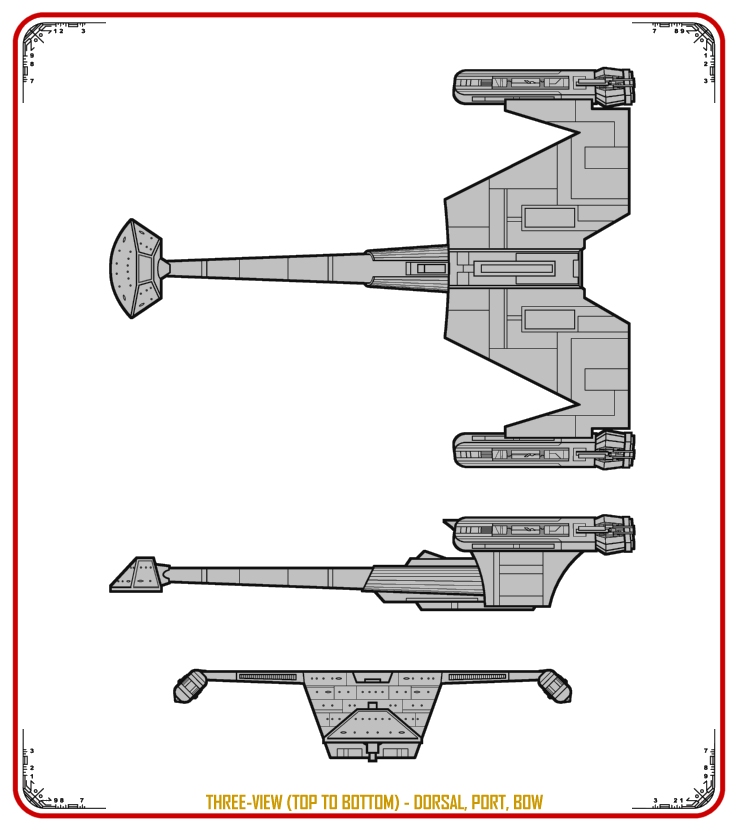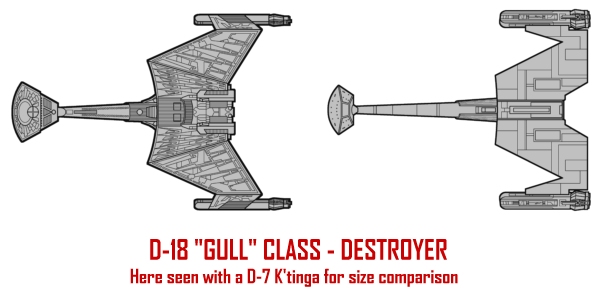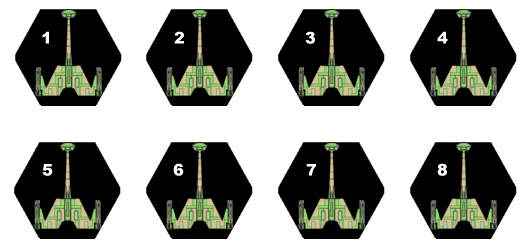|
A VERY CAPABLE DESTROYER, WITH
SOME GOOD old fashioned ST:TOS lines. (click
here for original FASA graphic) The D-18C is particularly fun to play
because of the cloaking capability, but even the D-18B is well matched against
similar destroyers from other Trek governments. This is one of the Klingon
destroyer designs that was given a considerable amount of backstory by the FASA
writers, and some of it is funny to read given decades of Trek progress since
the original manuals came out in the early to mid 1980s. There's that
mythic Triangle again, a place located on no canon star map, and never mentioned
in any episode script. Ditto for the Klingonese place names and the name
of the captain, Krezs sutai Kargon. Would that be Kresz of the
House of Kargon, or Kargon of the House of Kresz? It's obvious that in
1985 so much of the Klingon universe had yet to be fleshed out. Had the
backstory for this ship been written today, doubtless it would have been written
very differently.
— BRT
Additional comments, by Paul Steege, March 2004
Tonight, I was looking for size figures on the D-18, and saw your comments on
the rather extensive backstory done for this ship, particularly about Captain
Kresz sutai-Kargon, and thought I could shed a little light on this. I realize
that I can't possibly be the first person to point this out, but as long as I
was emailing you anyway, I figured I'd point it out anyway. That
particular style of Klingon name is based on those used in a novel called "The
Final Reflection," written by John M. Ford. The copyright date on the book is
1985, so it pre-dates all the TNG Klingon stuff. To equate it with the TNG
naming convention, it would in fact be Kresz of the House of Kargon. The "sutai"
bit is an honorific, sort of like the "-san," "-sama," and other honorifics used
in Japanese. A Klingon with no particular "fame" would be Kresz tai-Kargon,
sutai indicates a certain level of honor and/or glory, and the highest honorific
was epetai. (There may have been more than these three, but those are the ones I
remember off the top of my head--my copy seems to have disappeared again
tonight.) Ford's novel also shared the FASA concept of "fusions," Klingons whose
DNA was a combination of the "Imperial Race" (the post-TMP "ridged" Klingons")
and other races (such as human, resulting in the "smooth-headed" Klingons of the
Original Series). I've never been able to figure out which came first, Ford's
novel or the FASA game--I suppose it's possible that FASA actually created the
honorific system and Ford just borrowed it, but it seems like an unnecessary
detail for a starship combat game. Anyway, great work on the site, and thanks
for all the hard work you've put in on it.

From the FASA Star Trek KLINGON SHIP
RECOGNITION MANUAL, circa 1985
D-18 (Gull) Class VII - IX Destroyer
Known Sphere Of Operation: Empire-wide use
Data Reliability: A for D-18A and D-18B; C for D-18C
Major DataSource: A and B models in Star Fleet possession; Klingon Sector
Intelligence
The D-18, by far the most
widely-used destroyer in the Klingon Imperial Navy, is found in every region of
Klingon space and in the Triangle. There are even reports of D-18 groups
accompanying research efforts in the spinward areas.
Like other Klingon
vessels, the D-18 has the command pod forward of the main hull, though the boom
or neck is considerably smaller than on other designs. The thin neck has
no storage compartments or uses other than to contain a horizontal turbolift.
The pod has jettison mechanism coupled with a small impulse drive system, but,
unlike other self-contained pods, it contains no weapons. All the bridge
crew quarters are located in the pod, as are food synthesizers and life-support
systems.
The main hull of the D-18
is very large and spacious, featuring the very effective compartmented design to
reduce decompressive explosion in case of penetration. The warp drives are
mounted at the outer edge of the wings, giving the ship a gull-wing appearance
and its nickname. The warp engines may be jettisoned in case of an
overload, leaving the hull to operate with its impulse drive system located
center-aft. Inside the hull, forward of the impulse drive, is the
engineering section for the entire ship, occupying a roomy eight decks.
Forward of engineering, in the center-forward area of the main hull just above
the connecting point for the boom, is the impressive shuttle bay, containing
space for twelve shuttlecraft, more than most major warships. The beam
weapons are mounted on the underside of the main hull, with the forward-firing
KD-5s at the corners and center of the hull and the aft-firing KD-14 centrally
mounted; in later models, the KD-14 is mounted on the bottom of the torpedo bay.
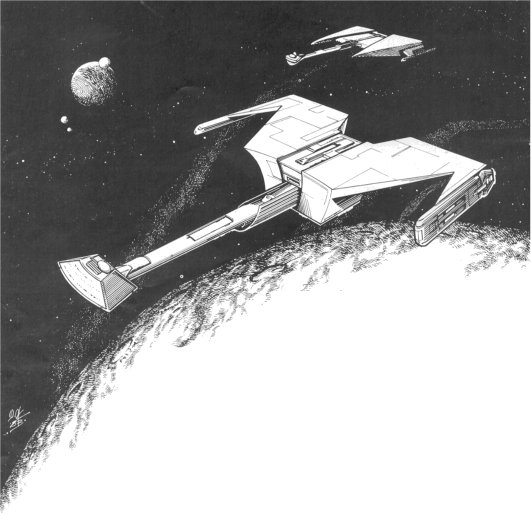 The D-18B and later models have command pods with an angular appearance and no
weaponry. In addition, the D-18B mounts the highly efficient KWE-3 warp
drive system, giving cruising speeds of Warp 8 and emergency speeds of Warp 9,
making the D-18B one of the fastest ships in known space, and providing more
maneuverability and more power to the weapons systems. The addition of
four more KD-5 disruptors gives this model the firepower lacking in the D18A.
The only drawback of this model is that when the additional engine mass was
added, the effectiveness of the shield generators decreased.
The D-18B and later models have command pods with an angular appearance and no
weaponry. In addition, the D-18B mounts the highly efficient KWE-3 warp
drive system, giving cruising speeds of Warp 8 and emergency speeds of Warp 9,
making the D-18B one of the fastest ships in known space, and providing more
maneuverability and more power to the weapons systems. The addition of
four more KD-5 disruptors gives this model the firepower lacking in the D18A.
The only drawback of this model is that when the additional engine mass was
added, the effectiveness of the shield generators decreased.
The D-18B, the most
common model to be encountered, has served the Klingon Imperial Navy well and
has been involved in many encounters both with the Federation and Romulans.
The most notable of these is 'The Kargon Incident'. In this skirmish,
Captain Kresz sutai Kargon, commanding a group of six D-18Bs, attacked a
Federation outpost located in the Orion sector. Responding to the
outpost's distress call was the USS Kongo (a Constitution class cruiser)
accompanied by the
USS Halk and USS Rome (both Loknar class frigates). The
Federation ships arrived too late to save the outpost, but not too late to
engage the Klingons. Detecting only three ships on sensors, one with
severe damage and the others with minor damage, Captain J.C. Fredriksen of the
Kongo ordered the Loknars to close with the Klingons and demand their
surrender.
In the meantime, the
Kongo approached the D-18 lying dead in space. As the Kongo
neared the vessel, sensors picked up three ships coming out of warp to the rear
and the systems aboard the dead ship coming to life. Captain Fredriksen
ordered the helmsman to turn hard about, but it was too late. The damaged
D-18 destructed with such tremendous force that the Kongo's starboard
warp nacelle was ripped from the hull and the port engine damaged beyond repair.
The incoming D-18s fired into the burning wreck of the Kongo and
completed the deed their comrades had begun. The Halk was so taken
by surprise that it, too, never had a chance to return fire, and the first
volley of shots from the oncoming D-18s totally destroyed the frigate. The
Rome, however, opened fire on one of the disabled D-18s and scored two
photon torpedo hits on its bridge and numerous phaser hits to its engines.
The Rome then turned on the other disabled D-18 and began firing as fast
as it could, scoring hits with every shot. The D-18s rushing in from their
attack on the Halk fired in unison, and the
Rome, though it had fought valiantly, suffered the same fate as the other
two Star Fleet vessels. News of this attack reached Star Fleet three days
later when a communications rnarker from the
Rome was retreived. From this report, it was also learned that the
Klingon ships in this engagement were painted in bright blue colors. Ships
of this description have been seen in and near the Triangle. Whether they
are the ships of Captain Kresz sutai Kargon is unknown.
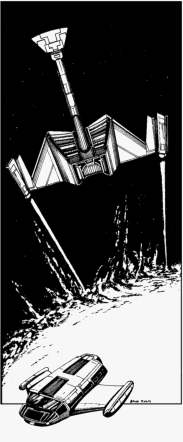 Of the 358 D-18Bs built, 257 remain in active service, 2 are used as training
vessels, 82 have been destroyed, 9 have been captured (5 by Star Fleet and 4 by
the Romulans), 4 are listed as missing, 1 has been scrapped, and 3 are in the
service of ranking families in the Empire. The D-18B is currently being
produced at the construction facilities located at H'renn and losia. These
facilities have an average production rate of 20 ships per year.
Of the 358 D-18Bs built, 257 remain in active service, 2 are used as training
vessels, 82 have been destroyed, 9 have been captured (5 by Star Fleet and 4 by
the Romulans), 4 are listed as missing, 1 has been scrapped, and 3 are in the
service of ranking families in the Empire. The D-18B is currently being
produced at the construction facilities located at H'renn and losia. These
facilities have an average production rate of 20 ships per year.
The D-18C has an
aft-firing photon torpedo, added to cover the weak spot of the ship. It
also mounts a KSD shield generator, which has a binary transformer that produces
shielding at twice the level of efficiency as the KSE system found on the D-188.
Of the 82 D-l8Cs built, 75 remain in active service, 4 have been destroyed, 1 is
listed as missing, and 2 have been sold to private interests in the Triangle.
The D-l8C is currently being produced at Taamar, Fonawl, and Mustaka.
Information received from Operation Dixie indicates that these facilities have a
combined production rate of 18 per year.
The Klingons call the
class
Laraatan, which translates to 'protector of brothers'. The class is
more commonly referred to as 'Gull' by Star Fleet personnel, an obvious
reference to its appearance.
When the D-I8A entered
service on Stardate 2/0108, the military situation along all borders was
relatively calm. The Klingons, still recovering from the war with the
Federation, did not wish to antagonize Star Fleet any more than necessary, so
the first groups of D-I8As were placed along the Romulan and Triangle borders.
For three years, the D-18As performed patrol duties without incident.
In the ship's first
combat test, three D-18s were ordered into the Triangle to intercept a Romulan
convoy and destroy the transports. Intelligence reports had shown that
there would be an escort of only one ship, a new R-4 about which nothing was
known. The D-18s approached the convoy from three different directions,
hoping to catch the escort with flanking fire and dispatch it easily. The
R-4 was not alone, however, but was accompanied by another R-4. The
Klingons began firing as soon as they were in range. In response, the
Romulans concentrated all fire on first one of the D-18s and then another, doing
heavy damage. The Klingon captains realized that their ships were
underpowered and undergunned for this type of mission, and began a fighting
withdrawal; one survived.
This engagement showed
the Imperial Command that the D-18 needed more efficient engines and a better
array of weapons. As originally designed, the pod on the D-I8A did carry
beam weapons, but, by Stardate 2/1512, all of the old A models had been
converted to Bs.
Of the 231 D-18As built, 156 have been converted to Bs, 62 have been destroyed,
4 (3 by the Romulans and 1 by Star Fleet) have been captured, 2 are listed as
missing, 3 have been scrapped, and 3 have been sold to private interests in the
Triangle.
|


